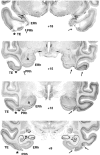The hippocampal/parahippocampal regions and recognition memory: insights from visual paired comparison versus object-delayed nonmatching in monkeys
- PMID: 14985444
- PMCID: PMC6730411
- DOI: 10.1523/JNEUROSCI.3763-03.2004
The hippocampal/parahippocampal regions and recognition memory: insights from visual paired comparison versus object-delayed nonmatching in monkeys
Abstract
Recognition memory was assessed by submitting the same adult monkeys to visual paired comparison (VPC) with mixed delays (10-120 sec), followed by three consecutive versions of object-delayed nonmatching-to-sample (DNMS): increasing delays (10-600 sec), lengthened lists (3-10 objects), and intervening distractors in the delays (light at 10 sec, motor task at 30-600 sec, or context change at 600 sec). Four groups were tested: normal controls, monkeys with ibotenic acid lesions of the hippocampal formation (H), and monkeys with aspiration lesions of either the perirhinal (PRh) or parahippocampal (areas TH/TF) cortex. Group H was impaired on VPC at delays > or =60 sec but had difficulty on DNMS only at 600 sec delays with distraction. In group TH/TF, the VPC impairment emerged earlier (30 sec); yet, once the nonmatching rule was mastered, no significant change occurred on any DNMS condition. Only group PRh behaved congruently on VPC and DNMS, exhibiting a deficit at the easiest condition that worsened with increasing delays as well as in DNMS lengthened list and distraction conditions. These results led us to postulate that VPC and DNMS, as previously administered to monkeys, were not equivalent visual recognition memory probes. Specifically, we propose that, for VPC, because of passive (incidental) encoding, the animal's performance rests on both item familiarity and event recollection, whereas, for DNMS, because of active (purposeful) encoding, performance relies more on item familiarity. This proposal converges with current models postulating distinct, but interactive, mnemonic roles for the hippocampal and adjacent TH/TF regions.
Figures











Similar articles
-
Neonatal aspiration lesions of the hippocampal formation impair visual recognition memory when assessed by paired-comparison task but not by delayed nonmatching-to-sample task.Hippocampus. 1999;9(6):609-16. doi: 10.1002/(SICI)1098-1063(1999)9:6<609::AID-HIPO1>3.0.CO;2-A. Hippocampus. 1999. PMID: 10641753
-
Memory for spatial location and object-place associations are differently processed by the hippocampal formation, parahippocampal areas TH/TF and perirhinal cortex.Hippocampus. 2008;18(1):64-80. doi: 10.1002/hipo.20369. Hippocampus. 2008. PMID: 17924520
-
Stimulus similarity and encoding time influence incidental recognition memory in adult monkeys with selective hippocampal lesions.Learn Mem. 2011 Feb 25;18(3):170-80. doi: 10.1101/lm.2076811. Print 2011. Learn Mem. 2011. PMID: 21357439 Free PMC article.
-
Effects of aging on visual recognition memory in the rhesus monkey.Neurobiol Aging. 1988 Sep-Dec;9(5-6):495-502. doi: 10.1016/s0197-4580(88)80103-9. Neurobiol Aging. 1988. PMID: 3062461 Review.
-
The parahippocampal region and object identification.Ann N Y Acad Sci. 2000 Jun;911:166-74. doi: 10.1111/j.1749-6632.2000.tb06725.x. Ann N Y Acad Sci. 2000. PMID: 10911873 Review.
Cited by
-
Recent and remote retrograde memory deficit in rats with medial entorhinal cortex lesions.Neurobiol Learn Mem. 2018 Nov;155:157-163. doi: 10.1016/j.nlm.2018.07.013. Epub 2018 Jul 31. Neurobiol Learn Mem. 2018. PMID: 30075194 Free PMC article.
-
Exploring Visual Selective Attention towards Novel Stimuli in Alzheimer's Disease Patients.Dement Geriatr Cogn Dis Extra. 2015 Dec 17;5(3):492-502. doi: 10.1159/000442383. eCollection 2015 Sep-Dec. Dement Geriatr Cogn Dis Extra. 2015. PMID: 26955382 Free PMC article.
-
Increased anxiety-like behaviors, but blunted cortisol stress response after neonatal hippocampal lesions in monkeys.Psychoneuroendocrinology. 2017 Feb;76:57-66. doi: 10.1016/j.psyneuen.2016.11.018. Epub 2016 Nov 18. Psychoneuroendocrinology. 2017. PMID: 27888771 Free PMC article.
-
Category-specificity in the human medial temporal lobe cortex.Hippocampus. 2009 Mar;19(3):308-19. doi: 10.1002/hipo.20515. Hippocampus. 2009. PMID: 18988234 Free PMC article.
-
What, if anything, can monkeys tell us about human amnesia when they can't say anything at all?Neuropsychologia. 2010 Jul;48(8):2385-405. doi: 10.1016/j.neuropsychologia.2010.01.011. Epub 2010 Jan 25. Neuropsychologia. 2010. PMID: 20097215 Free PMC article.
References
-
- Alvarado MC, Bachevalier J (2003) Damage to perirhinal and parahippocampal TH/TF cortices in monkeys impairs performance on transverse patterning. Soc Neurosci Abstr 29: 324.3.
-
- Alvarado MC, Mishkin M, Bachevalier J (1998) Neurotoxic lesions of the hippocampal formation impair monkeys' acquisition of the transverse patterning. Soc Neurosci Abstr 24: 928.
-
- Bachevalier J, Nemanic S, Alvarado MC (2002) The medial temporal lobe structures and object recognition memory in nonhuman primates. In: Neuropsychology of memory, Ed 2 (Squire LR, Schacter DL, eds), pp 326-338. New York: Guilford.
-
- Baxter MG, Murray EA (2001) Opposite relationship of hippocampal and rhinal cortex damage to delayed nonmatching-to-sample deficits in monkeys. Hippocampus 11: 61-71. - PubMed
-
- Beason-Held LL, Rosene DL, Killiany RJ, Moss MB (1999) Hippocampal formation lesions produce memory impairment in the rhesus monkey. Hippocampus 9: 562-574. - PubMed
Publication types
MeSH terms
Substances
Grants and funding
LinkOut - more resources
Full Text Sources
Other Literature Sources
Medical
Miscellaneous
